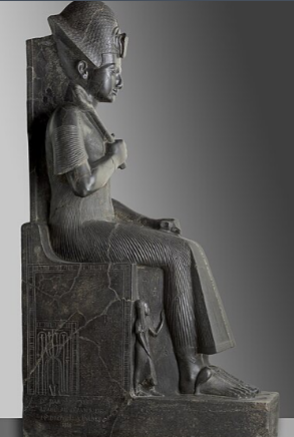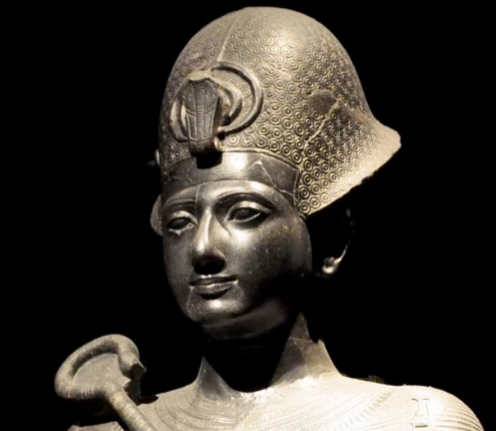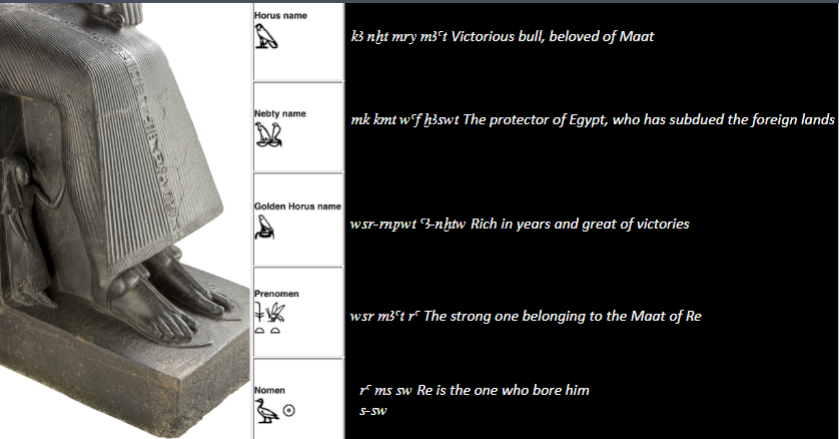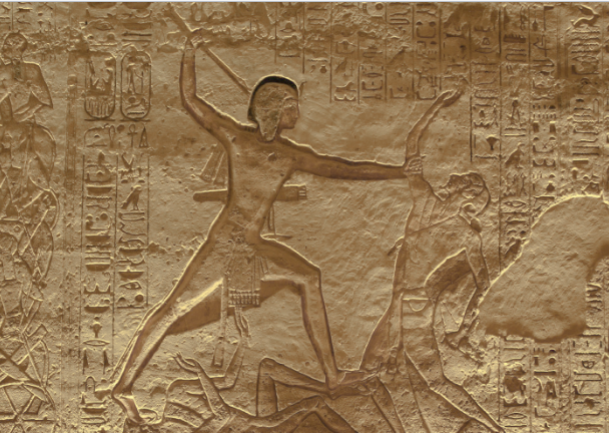Ramesses II, Warrior Pharaoh 10/11/24
1/9
Earn XP
Description and Tags
BGSU 1450
Name | Mastery | Learn | Test | Matching | Spaced |
|---|
No study sessions yet.
10 Terms
What is the New Kingdom Chorology?
Dynasty 18 1550 – 1292 BCE
Dynasty 19 1292 – 1189 BCE
Dynasty 20 1189 – 1077 BCE

Ramesses II
Dynasty 19
granodiorite
Karnak
Smaller waist, slim & fit, not scary, kingly outfit—would be white which also shows status (clean & in a desert), figurine at the bottom—is a child (shaved head & ponytail), hieratic scale


What does he wear here? What is it’s significance?
Ramesses II
Dynasty 19
granodiorite
Karnak
Khepresh—blue crown, not a single one survived, only lives on in statues and scripts. This crown is associated with war, and Ramesses wears this a lot
Ramesses looks young (always idealized, he died at 91)

What is the symbol here? What does it mean? What is carved in on the side?
sema-tawy—special symbol that means the unification of Egypt (upper & lower) (to be a true ruler, one must rule both).
sema—two, tawy—land, literally “two land”
TWO POSSIBILITIES:
A special plant that is intertwined, represents the North and the South or is the windpipe of a cow
19th century graffiti apparent

Why does Ramesses have so many names?
It highlights his accomplishments, divinity, powers, & STREET CRED (basically)

The “Temple of Ramesses, beloved of Amun,” dedicated to Amun, Ptah, Re-Horakhty, and Ramesses
II, 19 th Dynasty, c. 1264-1244 BCE, Abu Simbel, Southern Egypt/Lower Nubia, carved into solid
sandstone, statues c. 67’ tall.
All the statues here are Ramesses

The “Temple of Ramesses, beloved of Amun,” dedicated to Amun, Ptah, Re-Horakhty, and Ramesses
II, 19th Dynasty, c. 1264-1244 BCE, Abu Simbel, Southern Egypt/Lower Nubia, carved into solid
sandstone, statues c. 67’ tall.]
The woman is a wife of his, and the girl is his child/daughter, graffiti in all languages, even ancient Egyptian

Great hall of the temple of Ramesses II, Abu Simbel, with Osiride figures
Great Hall and Sanctuary, Temple of Ramesses
II, Abu Simbel.
Gets more narrow as you go farther in, used to be painted, all the statues are of Ramesses


Inner Sanctuary, with figures of Ptah, Amun-Re, Ramesses II, and Ra-Harakhte. Natural light reaches
this room only twice a year, on February 21 and October 21 when the sun rises over the east bank
of the Nile and a travels 160 feet into the deepest part of the temple.
Temple is really dedicated to Ramesses

Ramses during the battle
From Abu Simbel
Did not actually win despite the many, many, many images of him winning in battle
Egyptian-Hittite Peace Treaty -- Kadesh Peace Treaty
